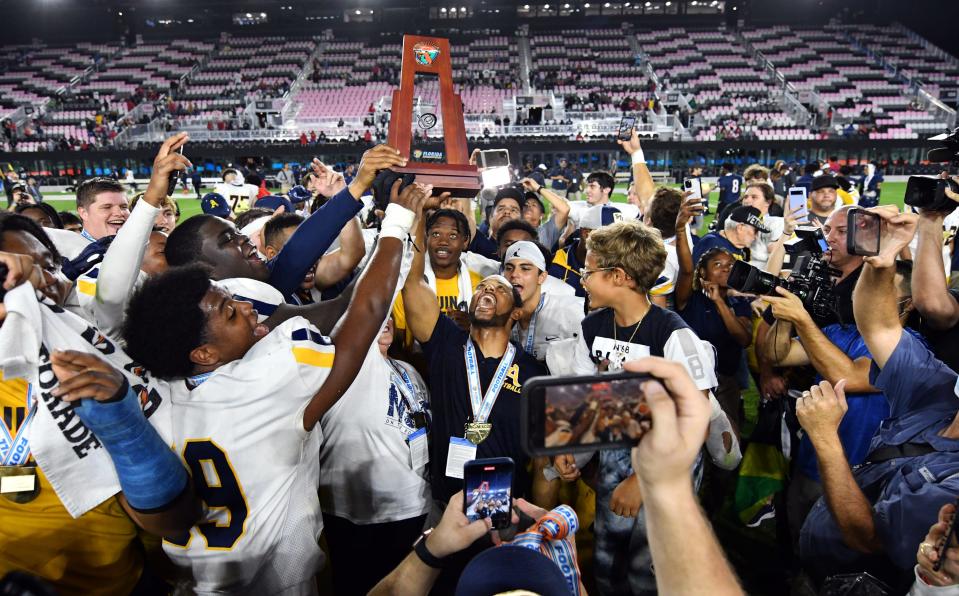Santucci: Want better football state championship games? Change the FHSAA's class formula
FORT LAUDERDALE — Ever get the feeling that you’re in you’re the right place and doing the right thing, but something just doesn’t feel right?
That’s how I felt Friday during the Florida High School Athletic Association’s football championships for Class 5A and 7A.
Miami Central and St. Thomas both claimed their third consecutive championships in games that had little drama and a running clock in the third quarter. Both teams started the season as No. 1 in the USA Today Florida Network poll and ended the season with the trophy.
Central won its five postseason games by an average of 30 points. Aquinas was even more impressive, winning each game by an average of 36.2 points.
Both of those teams are led by outstanding coaching staffs and are ridiculously talented, so I’m in no way implying that these titles weren’t earned on the field. What’s disappointing is that the state championship game should, on paper, be the best matchup not a mismatch where the outcome feels predetermined and inevitable.
More Recruiting Roundtable: Who did the best and what were the biggest surprises on Wednesday?
More Recruiting: Recruiting: Elite 2023 DE Damon Wilson scores on controversial pick-6 in state final
Free: Sign up for our new high school football recruiting newsletter

In some ways, you could argue it’s a one-year blip that could be solved with redistricting.
But therein lies the problem that’s keeping the state from potentially amazing state championship games. The formula to determine the classes doesn’t work.
The FHSAA formula is quick and easy. It’s based on school enrollment. It’s simple to understand.
And it’s doing a disservice to competitive balance.
It’s like looking at Disney and a county fair and saying, “Well they both have rides, so they’re the same.”
Of course, it’s not that simple. The idea that a private school, which can offer its coaches more money, potentially offer a better education and often have better facilities is on equal footing with a public school is laughable.
So is the idea that a school in Miami, Jacksonville or Tampa is on equal footing with a school in Pensacola, Vero Beach or Niceville.
Yet the FHSAA says that Niceville High School, a public school in a city of less than 16,000 people is on equal footing with Aquinas, a private school in the center of a county with more than 1.96 million people and draws athletes from both Miami-Dade and Palm Beach, with a combined population of more than four million.
Chaminade-Madonna, which pound-for-pound was one of the five best teams I saw this season, was the Class 3A state champion because of it has an enrollment between 361-739. But the private school from Hollywood went on the road to beat Sanford-Seminole, which has more than 4,000 students, Buford (Ga.) with an enrollment of more than 1,600 and just beat Highland (Az.), which has more than 3,000 students.
Cleary, enrollment isn’t the main issue in competitive balance.
So, here’s a proposal.
But first, a reality check. What I’m going to propose will never happen. South Florida schools will never agree to it and I understand why. But if competitive balance is a concern, just hear me out.
There should be a formula to determine the classes, which would include three main factors: population, enrollment and whether is a school is public or private.
The population factor should be the biggest component – maybe 50 percent. Draw a 20-mile radius around the school and that’s the population number. Some kids certainly can come from farther away, but it’s not the norm. If one school can draw from 3.5 million and another can draw from 39,000, there is no way they should be expected to compete. Ever.
Enrollment would be a factor – maybe 25-30 percent, but no higher.
Public or private is the final factor – against 20-25 percent. And that’s probably being generous. But it should factor in and I’m certainly sympathetic to those who shout that public schools and private schools should be in different classes.
It would create much different championship matchups, that’s for sure.
But would anyone be upset with a Class 8A final four of Jesuit, St. Thomas Aquinas, Apopka and Columbus? Or a 7A final four of Miami Central, Tampa Bay Tech, Cardinal Gibbons and Jones. Or a 5A final four of Venice, Treasure Coast, Pine Forest and Chaminade-Madonna?
My argument comes down to two main things.
Enrollment shouldn’t be the primary factor is determining competitive balance.
And, more importantly, a state championship game should be the best possible matchup, not simply a coronation.
This article originally appeared on Palm Beach Post: Want better football state championship games? Change the FHSAA classes

